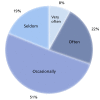Resident duty hours in Canada: a survey and national statement
- PMID: 25559388
- PMCID: PMC4304289
- DOI: 10.1186/1472-6920-14-S1-S9
Resident duty hours in Canada: a survey and national statement
Abstract
Physicians in general, and residents in particular, are adapting to duty schedules in which they have fewer continuous work hours; however, there are no Canadian guidelines on duty hours restrictions. To better inform resident duty hour policy in Canada, we set out to prepare a set of recommendations that would draw upon evidence reported in the literature and reflect the experiences of resident members of the Canadian Association of Internes and Residents (CAIR). A survey was prepared and distributed electronically to all resident members of CAIR. A total of 1796 eligible residents participated in the survey. Of those who responded, 38% (601) reported that they felt they could safely provide care for up to 16 continuous hours, and 20% (315) said that 12 continuous hours was the maximum period during which they could safely provide care (n=1592). Eighty-two percent (1316) reported their perception that the quality of care they had provided suffered because of the number of consecutive hours worked (n=1598). Only 52% (830) had received training in handover (n=1594); those who had received such training reported that it was commonly provided through informal modelling. On the basis of these data and the existing literature, CAIR recommends that resident duty hours be managed in a way that does not endanger the health of residents or patients; does not impair education; is flexible; and does not violate ethical or legal standards. Further, residents should be formally trained in handover skills and alternative duty hour models.
Figures



References
-
- Beluz J. Pan-Canadian standard needed for duty hours. Med Post. 2011.
-
- Cardwell M. State of the postgrad nation. Med Post. 2011.
Publication types
MeSH terms
LinkOut - more resources
Full Text Sources
Other Literature Sources
Medical

